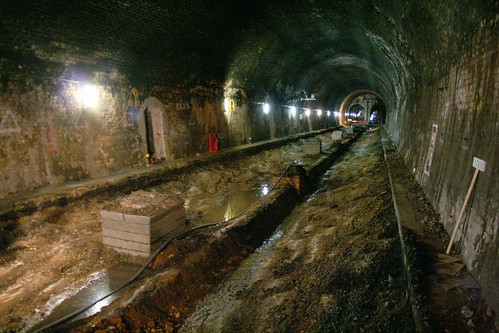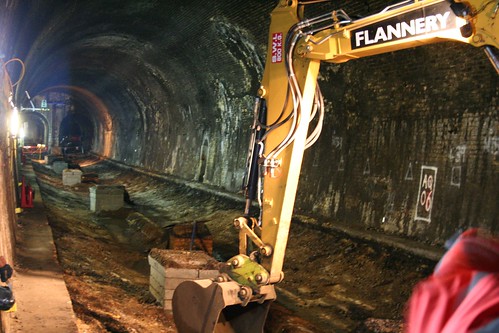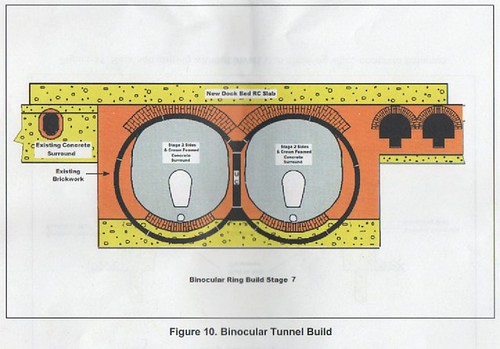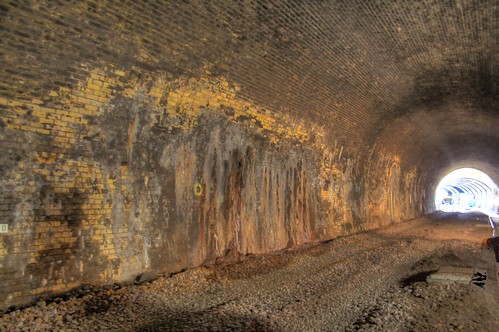Last April I had a chance to walk through the length of the Connaught Tunnel, a disused railway tunnel in Docklands that will be refurbished for Crossrail.
Today I went back for another look, although due to the now ongoing works, not quite all the way through to the other end. Today was also a chance to be briefed on some changes to the refurbishment plans, and why those changes have taken place.
The site visit started with a briefing about the ongoing works to test the ground for left-over bombs from WW2. More about that another day.
It is possibly an interesting contrast that while one team in East London are testing for German bombs, over by Paddington, another team are assembling the German built tunnel boring machine that will dig the tunnels.
Once we finished prodding the ground (electronically) for bombs, it was back down into the tunnels – officially so that BBC London could get some good footage, but also so myself and the editor of London Reconnections could take some photos of the ongoing works.
Since I was last there, all the vegetation has been dug out, as have the railway tracks and rotting wooden sleepers. They are now removing the old ballast to strip the tunnel back to its empty state. This work is nearly completed, with the northern half finished, and work on the southern half — where we were — underway.
What will happen then is that the sides of the tunnels will be underpinned with concrete supports, then dug down to lower the base of the tunnel so that the larger Crossrail trains (and their overhead wires) can fit into the tunnels.
That’s a very delicate job and although the actual digging work is minimal, the temporary supports needed to hold everything in place will consume a lot of effort.
Although a vast tunnel, the lack of airflow and other unexpected nasties possibly being down there, means this is an environment you aren’t allowed into without an emergency oxygen supply that each of us carried in a tin lunchbox.
In the photo below, you can see how the ballast has been removed – and in the far distance the two smaller bore tunnels that were inserted into the larger structure in the 1930s.
As you may recall from my previous visit, the two smaller tunnels run under a narrow water channel that links two docks above, and in the 1930s, the docks were deepened – resulting in the “insert” of the brick and iron lined section.
The original plan was to put a concrete slab in the docks above and then dig out the iron rings, fill in the tunnels with a light concrete foam to stop them collapsing, then drill out the new larger Crossrail tunnels.
Plans cancelled!
Turns out that the roof of the tunnels/floor of the docks are somewhat thinner than they thought, and in a far worse state than had been expected.
The new plans are actually rather better for us bystanders.
Starting next January, two dams will be put either side of the short canal and the water drained. They then plan to dig down from above and cut out all the iron tunnel linings and install a “cut and cover” concrete box to replace the older structure.
The great thing about that way of preparing this part of the tunnel, is that a lot of it should be visible to curious people from the footbridge that runs over the top of the site. Which is very nice!
I am also especially keen to find out what the three smaller mystery tunnels are. Some sonar soundings have proven the tunnels exist, although it is likely that the roof has collapsed in a couple of places. They also found a car (since removed) and what might be a drivers cabin for a lorry (still there).
Incidentally, it turns out when a car is dumped in a watery grave, the police send down divers to check it is unoccupied, and then remove the license plates as a sign that they have done their work. So if dredgers find an abandoned car and it still has license plates, that’s a moment to call in the police.
Fortunately, the plans to restore the rest of the Victorian tunnels are still in place and some cleaning of the brickwork is under way in areas. Due to the surprisingly fragile nature of Victorian brickwork, various experiments found that steam cleaning gets the most dirt removed for the minimum damage. With 140 years of steam, grease and dirt to remove, it’ll never be pristine, but actually, I am quite pleased about that.
Keep some of the dirt – it’s part of the heritage of the place.
Some more photos here.













This stuff is always so fascinating. How do you get to go exploring? I’d love to!
Agree with Lleyam, these are fantastic articles!
Fascinating story as always. Thanks Ian.
“It is possibly an interesting contrast that while one team in East London are testing for German bombs, over by Paddington, another team are assembling the German built tunnel boring machine that will dig the tunnels”
Good grief – i can’t believe you wrote that. Would it be an interesting contrast if the team in East London drove there in a Mercedes van or had been wearing Adidas trainers? Conflating wartime Nazi Germany with modern day Germany is … well, stupid, and I would think you should know better.
Fascinating stuff. Thanks.
The access map in your photos. I hope the Crossrail team aren’t really using that map, as it is missing some significant recent changes. The position of the access road into LCY is shown as leading off the roundabout, but in reality it has moved.
Furthermore, the route marked as “lorry access” goes right through the middle of the private jet terminal at LCY. One hopes that the Crossrail people have talked to the people at LCY aboit that!
It’s an old illustrative only map from before Crossrail bill was approved – it just happens to be the best one I can find.